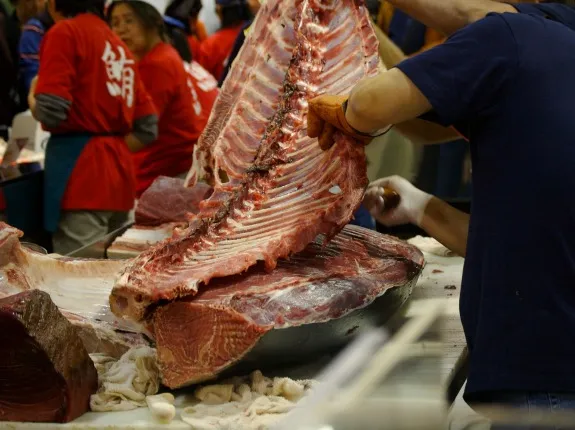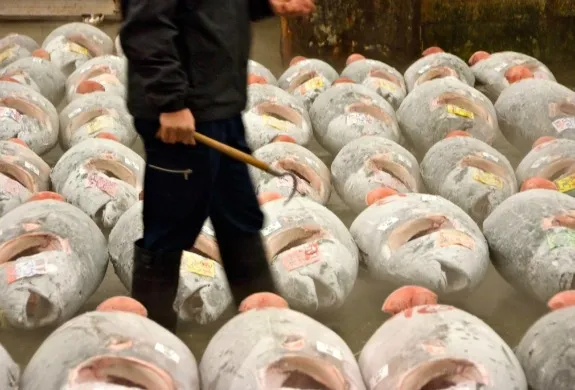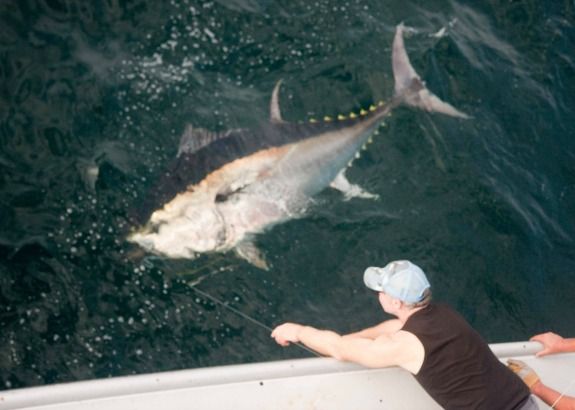From Cat Food to Sushi Counter: The Strange Rise of the Bluefin Tuna
The fish can sell for hundreds of thousands of dollars each. But just 45 years ago, big bluefin tuna were caught for fun, killed and ground into pet food
/https://tf-cmsv2-smithsonianmag-media.s3.amazonaws.com/filer/20130911120109BluefinToro-web.jpg)
In January, a single bluefin tuna was purchased by a wealthy restaurateur in Tokyo for nearly $2 million—something of a publicity stunt yet indicative of just how much the modern sushi industry values this creature. Japanese chefs handle cuts of red bluefin flesh as reverently as Italians might a white truffle, or a French oenophile a bottle of a 1945 Bordeaux. And a single sliver of the fat, buttery belly meat, called toro, or sometimes o-toro, in Japanese, can pull $25 from one’s wallet. The bluefin, truly, is probably the most prized and valuable fish in the world.
But it wasn’t always this way. Several decades ago, the very same fish were essentially worthless worldwide. People caught them for fun along the Atlantic Coast—especially in Nova Scotia, Maine and Massachusetts—and though few ever ate their catch, they didn’t usually let the tuna go, either. During the height of the tuna sport fishing craze in the 1940s, ’50s and ’60s, the big fish were weighed and photographed, then sent to landfills. Others were mashed up into pet food. Perhaps the best of scenarios was when dead bluefin tuna—which usually weighed at least 400 pounds—were dumped back into the sea, where at least their biomass was recycled into the marine food web. But it all amounts to the same point: The mighty bluefin tuna was a trash fish.
The beef-red flesh, many say, is smelly and strong tasting, and, historically, the collective palate of Japan preferred milder species, like the various white-fleshed fishes and shellfish still popular among many sushi chefs. Other tuna species, too—including yellowfin and bigeye—were unpopular in Japan, and only in the 19th century did this begin to change. So says Trevor Corson, author of the 2007 book The Story of Sushi. Corson told Food and Think in an interview that an increase in tuna landings in the 1830s and early 1840s provided Tokyo street vendors with a surplus of cheap tuna. The meat was not a delicacy, by any means. Nor was it even known as a food product. In fact, tuna was commonly called neko-matagi, meaning “fish that even a cat would disdain.” But at least one sidewalk sushi chef tried something new, slicing the raw meat thin, dousing it in soy sauce and serving it as “nigiri sushi.”
The style caught on, though most of the chefs used yellowfin tuna. Occasionally, chefs made use of large bluefins, and one trick they learned to soften the rich flavor of the meat was to age it underground for several days. The way Japanese diners regarded raw, ruddy fish flesh began changing. This marked a turning point in the history of sushi, Corson says—but he points out that the bluefin tuna would remain essentially unwanted for decades more.

In the early 20th century, sport fishing began gaining popularity in the United States and Canada—and few fish were more exciting to hunt than the giant bluefins that migrated about the Atlantic and passed through near-shore waters in New England and southeast Canada. In Wedgeport, Nova Scotia, interest in catching giant bluefins proliferated among wealthy boat fishermen armed with enormous, crane-like rods and reels, and in 1937, local organizers held the first International Tuna Cup Match.
The event became a festive annual gala of wealthy boatmen vying for victory. Naturally, it was also a brutal bloodfest. The 1949 event saw 72 bluefin tuna landed—the highest number ever caught in the 28-year span the derby was held. The fish were giants, averaging 419 pounds. Such exact measurement depended on subduing and killing them, and almost certainly, most were later discarded. Author Paul Greenberg writes in his 2010 book Four Fish, which profiles the bluefin as among the world’s most important seafood species, that just like the Japanese at the time, “Americans considered bluefin too bloody to eat and had no interest in bringing home their catch.”
Many—probably thousands—of enormous bluefins caught last century by sport fishermen were killed, hoisted for photographs, then either thrown out entirely or sold to processors of cat and dog food.
The dramatic turnaround began in the early 1970s. Beef had become popular in Japan, and with a national palate now more appreciative of strong flavors and dark flesh, bluefin tuna became a desired item. It was also about this time that cargo planes delivering electronics from Japan to the United States and returning home empty began taking advantage of the opportunity to buy cheap tuna carcasses near New England fishing docks and sell them back in Japan for thousands of dollars.
“Bluefin tuna is an amazing example of something we have been made to think is an authentic Japanese tradition,” Corson says. “Really, it was a marketing scheme of the Japanese airline industry.”
Corson says that advancements in refrigeration technology at about this time facilitated what was growing quickly into a new and prosperous industry. Now able to freeze and preserve all the tuna they could carry at sea, operators of huge fishing vessels were able to return home with lucrative hauls. By the time sport angler Ken Fraser caught a 13-foot-long Nova Scotia tuna in 1979 that weighed 1,496 pounds, things had changed for the bluefin. People were still killing them—but not wasting them.
Even sport fishermen often purchased commercial licenses, intending to sell what they caught to the Japanese sushi market. Giant bluefin would no longer be sent to pet food factories. The species had become a delicacy. The popularity spread back across the ocean, and soon Americans developed a taste for bluefin meat. By the 1990s, the bluefin tuna was wanted almost desperately worldwide.

The rest of the bluefin story has been told many times, but the worsening scenario mandates a quick recap: The Atlantic species has crashed from rapturous, water-thrashing abundance to scarcity. It has been estimated that a mere 9,000 adults still spawn each year in the Mediterranean. A British scientist named Callum Roberts estimated that for every 50 bluefins swimming in the Atlantic Ocean in 1940 there was just one in 2010. By most accounts, the population is down by more than 80 percent. The Pacific bluefin, smaller and genetically distinct from the Atlantic species, has fared better over the decades, but the relentless sushi industry seems to eventually catch up with all fatty, fast-swimming pelagics. Fishery scientists recently estimated the Pacific stocks to be just 4 percent of their virgin, pre-fishery biomass. Ironically, in the days when the bluefin’s value has never been higher, sport fishermen are increasingly releasingthe tuna they catch.
Corson, once a commercial fisherman himself, no longer eats bluefin.
“It’s not even that good,” he says. “It’s got this distinct, not-so-subtle, tangy iron flavor, and it melts in your mouth. This makes it very easy to like.” Too easy, that is. Corson says that “old-school sushi holdouts who are still loyal to the older version of sushi” share the same opinion. Among these diners and chefs, the melt-in-your-mouth sensation that has proved so marketable and so devastating to the bluefin tuna is considered simplistic and unsophisticated. “They consider toro to be sort of for amateurs,” Corson says. Instead, traditional sushi connoisseurs enjoy the often crunchier, more subtly flavored muscle tissues of animals like squid, clams, various jacks, flounder and, perhaps most of all, sea bream, or Pagrus major.
To help reveal to others the authentic history of sushi and just how gratifying it can be to eat lesser known species rather than the blubbery bluefin tuna, Corson leads regular tasting classes in New York City. “I’m trying in my own little way to show one person at a time how great traditional sushi can be,” he says. Bluefin is not on the menu at these events.
Whether the culinary world will embrace the true traditions of sushi and turn away from bluefin before the species goes commercially extinct is unclear. Corson notes that he has never seen a species go from coveted delicacy to reviled junk fish. “It’s usually a process of expansion,” he says.
Indeed, restaurant owner Kiyoshi Kimura’s purchase of a 488-pound bluefin for $1.76 million at the Tsukiji fish market this January indicates that the bluefin is more valued than ever now. We might drop our jaws at this, thinking it obscenely wasteful. And though it was similarly wasteful to grind countless big tuna, from head to tail to toro, into cat food, it does seem that the bluefin might have been better off had we just gone on regarding it as trash.

/https://tf-cmsv2-smithsonianmag-media.s3.amazonaws.com/accounts/headshot/Off-Road-alastair-bland-240.jpg)
/https://tf-cmsv2-smithsonianmag-media.s3.amazonaws.com/accounts/headshot/Off-Road-alastair-bland-240.jpg)